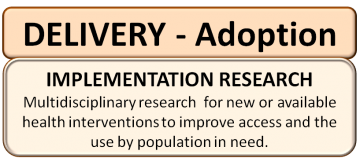Diarrhea and Sepsis
Charles Larson
Scale Up of Zinc Treatment of Childhood Diarrhea:
This project aims to support the effective and sustained scale-up of the treatment of childhood diarrhoea with zinc and ‘low osmolarity Oral Rehydration Salts (ORS), so as to contribute in turn to the reduction of diarrhea-related child morbidity and mortality in Senegal. This support will be used to improve both the health-seeking behaviour of caregivers during diarrhea episodes of children and the accessibility, utilization, and coverage of high quality diarrhoea treatment with zinc and low osmolarity ORS.
Interrupting Pathways to Childhood Sepsis: Early detection and interruption of pathways to sepsis among women, newborns and young children in least developed countries has been a largely neglected and misunderstood issue. Sepsis is the final common pathway to death for nearly all serious childhood infectious illnesses. Of the nearly 8 million under-five children who die each year, it is estimated that 50 to 70% of these deaths will be the result of children entering this pathway. In partnership with several Bangladeshi and Canadian organizations, this project will establish demonstration sites in which integrated innovations will be implemented and evaluated that involve the coordinated actions of communities, midwives, and primary or hospital care providers in adopting and strengthening mHealth communication and diagnostic innovations, early intervention [detection + referral/transport + treatment] of childhood infections and strengthened health systems.
HIV/AID & Tuberculosis
Annalee Yassi
Prevention, Diagnosis, and Treatment of HIV and TB in the Workplace:
With funds from the Global Health Research Initiative’s Canadian HIV Vaccine Initiative program, we are developing, implementing, and evaluating a program to build capacity in South Africa to implement and evaluate programs for prevention, diagnosis, and treatment of HIV and TB in the workplace. This project uses our online learning modules, as well as problem-based learning, but especially community-based learning, as all participants have to implement and evaluate HIV and TB in their own workplaces as part of their training.
PRE-ECLAMPSIA
Peter von Dadelszen
Prediction in Pre-Eclampsia: PIERS (Pre-eclampsia Integrated Estimate of RiSk)
We are investigating a range of potential predictors of adverse maternal outcomes in women admitted to hospital with pre-eclampsia. We identified the feasibility of, and need to perform, a prospective outcome prediction model development and initial validation study, which was completed in seven centres internationally with CIHR support. This model, the PIERS model, is now being re-validated in two versions.
The first version, fullPIERS, is for use in well-resourced settings and is being validated in level I-III units in Canada, New Zealand, Australia, and the UK in women with pre-eclampsia and the other hypertensive disorders of pregnancy. The validation of fullPIERS has the support of the CIHR.
In parallel, we are also validating the miniPIERS model, which is symptom and signed-based, for use in rural and remote communities and low and middle income countries. The re-validation of miniPIERS has the support of the World Health Organization and the CIHR, and is taking place in Brazil, Pakistan, Mali, China, Uganda, South Africa, and Fiji.
EMMA (Evaluating Maternal Markers of Acquired risk for pre-eclampsia)
We also received CIHR support to develop a screening test to predict the development of pre-eclampsia. This model, the EMMA model, was developed in a high risk cohort of women and identifies women of incremental risk for the later development of pre-eclampsia and the other placental complications of pregnancy (gestational hypertension, IUGR, abruption, stillbirth, and preterm birth).
[Back to top]
Education
Olga Pena
Accessible Science Initiative (ASI)
The ASI is a student led, non-for-profit organization from the University of British Columbia (UBC) located in Vancouver, Canada, working under the umbrella of the Liu Institute for Global Issues at UBC and with the support of faculty members from a variety of disciplines at the university. Their mission is based in three pillars:
Education
To generate science (hands-on/training courses) projects in primary, secondary schools and universities, using culturally relevant topics that awake a passion for science and encourage the engagement towards careers in the basic and health sciences.
To promote the importance of science literacy and research, through general public activities, in order to show how this can have a positive impact in the quality of life.
Technical Support
To collect and disseminate new and gently used scientific instruments, materials, and equipment of vital need for the development of science education and research projects in low-income schools and universities. Similarly, to collect books and scientific journals that will help existing research groups stay up-to-date in their research areas.
Exchange of Knowledge
To encourage UBC scientists to share their knowledge and collaborate with their respective colleagues in developing countries. Similarly, UBC undergraduates, graduates students and alumni can join this initiative by bringing their knowledge and expertise to the developing world, either in person or through electronic contact, helping teachers or scientific research groups in these regions reach their goals.
To disseminate information about the different programs (Scholarships, Grants, Travel Awards) offered by governments or institutions for undergraduate and graduate students from developing countries to pursue science research internships in North American universities.
To advocate for open access publishing in science, allowing knowledge to be equally accessible for those in developing countries.
[Back to top]
